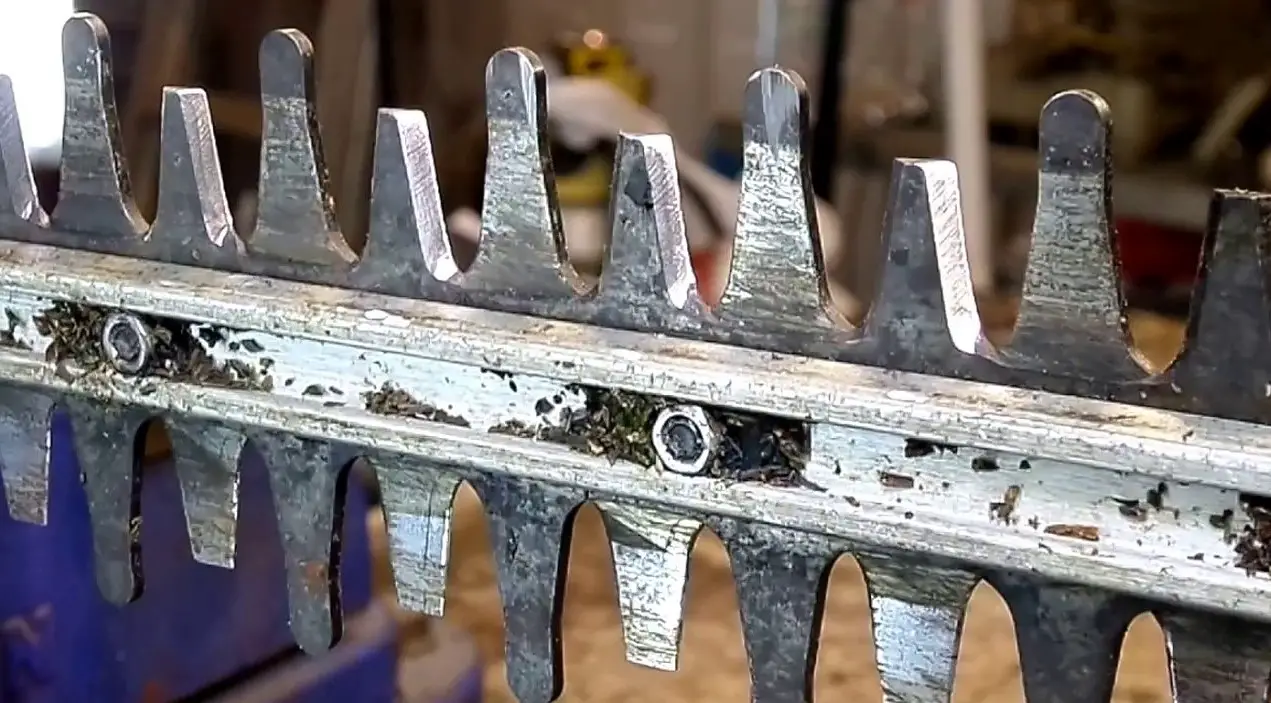Hedge trimmers are a hugely effective gardening tool, but only if the hedge trimmer blades are in good condition. When your hedge trimmer loses its cutting edge, it becomes less effective. Dull blades make trimming branches harder, which is why you need sharp shears and blades to tackle thick branches.
Thankfully, you can sharpen hedge trimmer blades, and this guide will show you that sharpening your hedge trimmer isn’t too difficult a task.
Can you sharpen hedge trimmers?
Yes.
It is possible to sharpen the blades, and you have several ways you can do so. One recommended way to sharpen your hedge trimmer is by hand using a flat-file and whetstone. This method takes a little concentration and care, but it delivers fantastic results, ensuring your hedge trimmers are in excellent condition.
Safety first when sharpening hedge trimmer blades
No matter which method you use to sharpen the hedge trimmer blades, you must focus on safety. Protect yourself by wearing safety gear, and make sure you wear safety glasses and gloves.
Be careful of the cutting edge of cordless hedge trimmers
No matter how you use a power tool or tools, you must be careful with the cutting edge. A sharp tip can cause significant damage, so watch what you are doing, and always wear protective clothing.
How to sharpen Stihl hedge trimmers
Given Stihl hedge trimmers are amongst the most popular hedge trimmers on the market and market leaders, people expect a good standard of cutting power from these trimmers. If your Stihl trimmers are not as effective as they used to be, you should consider sharpening them.
How to tell if your hedge trimmer needs sharpening
Over time, even the best blades will become blunt through frequent use, but there are instances Stihl advise users to look out for as a sign of trimmers losing their edge:
- When you have branches jamming in the trimmer, it is an indicator you need to sharpen your blades
- If you notice twigs or branches are not cutting cleanly and that there are uneven or frayed edges, your blades will benefit from a sharpening process.
While Stihl suggests users can visit a dealer to have their product sharpened, they also offer guidance on how users can sharpen their hedge trimmers at home.
Ensure your electric hedge trimmer has sharp blades
Stihl advises users to have the following materials and right tools at hand when sharpening their electric hedge trimmer:
- Flat file
- Safety clothing
- Safety glasses or face protection
- Soft cloth
- STIHL resin solvent
- Water
- Whetstone
- Work gloves
It is best to be proactive rather than reactive when maintaining your blades and hedge trimmers. Doing so will extend the lifespan of your electric hedge trimmers.
How often should I sharpen the blades?
Stihl recommends users sharpen their trimmer every 50 hours, which will deliver a consistent cutting standard.
Cleaning the teeth of your trimmer
Given that sap and resin accumulate on a hedge trimmer when used, you must clean it before starting the sharpening process. You can remove sap, resin, dirt, dust and debris by using a soft cloth and soapy water.
Use a flat file to sharpen the hedge trimmer blades
When using a flat file, start sharpening by filing in the cutting edge direction. A flat file assists with this process, as it only operates in one direction. Filing in this direction helps you enjoy a sharp and even blade.
Find the best sharpening angle
Please review the operating instructions for your trimmer to find the recommended cutting angle of sharpening for your trimmer. This differs across the range of products provided by Stihl, so there is no universal angle for sharpening the blades. You’ll find the best starting position for your machine online, or in your instruction manual.
A tip to file with care – only work on the forward stroke
The flat file only works when you work on the forward stroke. You should avoid a sawing motion; lifting the file from the saw is best when you move back to the start. If you fail to do this, you risk blunting the trimmer blades.
Be mindful of the wear threshold
When filing blades, be careful not to remove excessive material during the sharpening process. Stihl advises the abrasion limit is only 5mm. Anyone who happens to file off too much material runs the risk of compromising the trimmer’s performance, making it useless.
You should look to file each edge for the same number of times, as this will ensure that all blades and cutting edges are sharpened to the same length.
Using the whetstone to remove burrs
The filing process might lead to burrs on your blades’ lower side.
You should flip the hedge trimmer over to work on the blades’ back. As you carry out this work, take steps to lightly moisten the trimmer . You should move the whetstone in a slow, swiping motion towards the tip of each blade. As you do, you will smooth out burrs and any uneven or rough surface, banishing burrs in a simple way.
After-care
To properly maintain your Stihl trimmer, you need to carry out a few extra steps when you have finished sharpening. This maintains your tool in good condition, it will help prevent rust and can help you re sharpen the tool more easily later.
Sharpen hedge trimmer blades and protect every blade
By filing the trimmer, you’ll likely have removed a degree of corrosion protection from the blades. Stihl advise you to apply the blades with a layer of their branded resin solvent.
This helps maintain the overall condition of your trimmer, ensuring you enjoy the product for many years.
Developing regular maintenance habits, for the upper and lower blades will protect your machinery, and ensure your cutting power remains in place for many years to come.
How to sharpen Ryobi hedge trimmer
Ryobi is recognised as one of the leading innovators in the garden tool sector, and many people have their hedge trimmers at home or in their place of work.
Confidently sharpening your hedge trimmer
The company is keen for users to care for their devices, ensuring longevity. As you would expect, Ryobi offers guidance on sharpening the blades, including using tools, if required:
- Remove the battery pack from the trimmer.
- Make sure there are no moving parts or sharp blade sticking out
- Use a bench vice to clamp the blade trimmer and then use an 8-inch smooth file on each exposed blade tooth – feel free to adjust the vice to a level you are comfortable with, but ensure the trimmer is secure
- Remove the trimmer from the vice, and then replace the battery pack with the trimmer.
- Start the trimmer to allow the blades to move so that the exposed blades are the ones that haven’t been sharpened.
- You should then repeat removing the battery pack, securing the trimmer in a vice, and then filing the exposed blades.
As you’ll see, the instructions for sharpening a Ryobi hedge trimmer are simple, straightforward, and intuitive. This process ensures you sharpen all the blades of your hedge trimmer
The company’s advice of using a vice indicates safety is crucial, and you should wear gloves and goggles as you sharpen your hedge blades and trimmer.
Sharpen your hedge trimmer
Hopefully, these steps help you sharpen the blades of your electric hedge trimmer or cordless hedge trimmer. Without a good cutting edge, cordless hedge trimmers aren’t good value.
Of course, when you improve each blade, cordless hedge trimmers are highly effective in improving your upper and lower blades enough they can cut hedges, remove thick branches and make their way through tough material.


